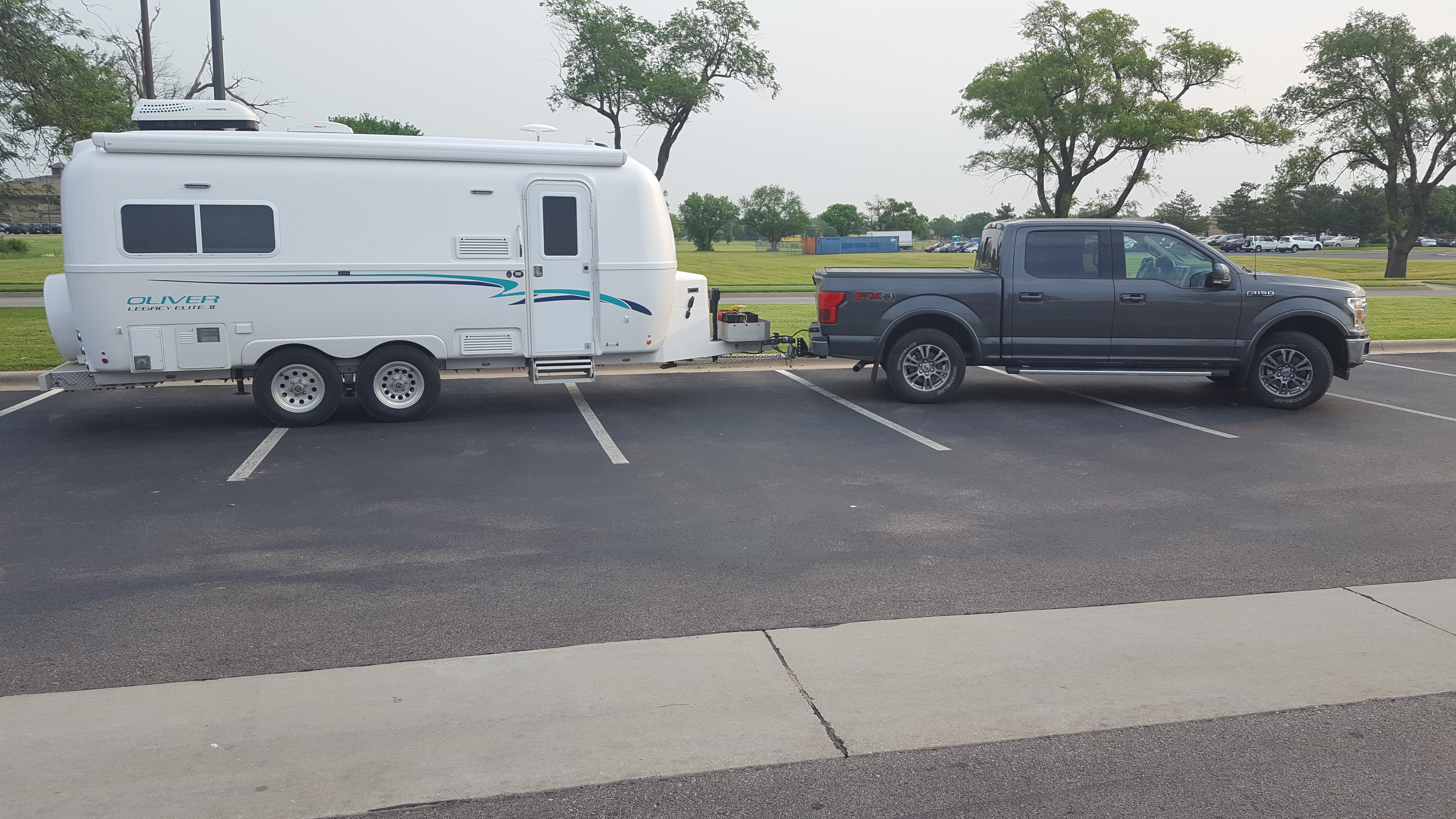-
Posts
2,012 -
Joined
-
Last visited
-
Days Won
53
Posts posted by Geronimo John
-
-
52 minutes ago, Cort said:
Yes, that's what I'm planning to do - replace the two broken springs and get back on the road - and at some point upgrade.
That leaves you with two more springs begging to fail. Suggest if the cost of the ALCON's are a concern, then get four of the Dexter PR4's. It is 2400 # rated.
-
9 hours ago, John Dorrer said:
Starting in 2022 Oliver went to the 5200 lb axels. There have been few if any failures on the trailers from 2022 to present.
I believe the 5200 pound axles are a great upgrade. When I need a brake job, I plan on doing mine.
But their springs need to be upgraded as well. I understand that some "Lucky" owners have the bigger axles (YEA! for them). BUT they have the 1750# springs. In no way I can think of would they NOT have the same spring issue as all the 3500 # axles. So inspections are in order for them as well.
-
 2
2
-
-
On 6/19/2025 at 12:49 PM, jd1923 said:
Leaf springs need to handle the weight of the trailer regardless of conditions. Hitting an uneven bridge seam or RR tracks on a 65 MPH highway is a lot more stress on springs and shocks than the bumpiest road traveling <20 MPH.
I agree if the road is port to starboard level.
I have repeatedly made the distinction between the 15% and 85% group. WHY?
The 15% group are far more likely to "duck walk" their trailer. This is hard on the springs and shackles. But worse is when you transverse an area where the trailer and TV are on a steep side-slope. Doing so causes a LOT more weight to be transferred to the downslope side of the axle. Doing so twists the spring pack and racks the shackle. Now the springs and shackles pick up not say 1500 pounds, but likely many more hundreds of pounds extra load and worse the torque between the frame and axle moment. This is when you really qualify as a 15%er and need those Alcan 5 spring packs.
I than asked the question how many of our owners actually transverse gullies sideways, duck walk, or travel on side-slopes as part of their joy with an OE2? My guess is 15%.
The rest of us may boondock and use graded fire roads. But we would not want the harsher ride of the super duty shackles/spring setup.
However, IMHO the 15%ers would benefit greatly by the stronger more torsion resistant heavy duty 5 pack suspension.
And Cord is very likely a 15%er!
GJ
-
 1
1
-
 3
3
-
-
On 6/19/2025 at 7:02 AM, jd1923 said:
I believe the part number SW4B is all you need to order.
I ordered these from SW Wheel which you can see online for reference:
SW4B-BR TruRyde® 4 Leaf 25 1/4" Double Eye Trailer Leaf Spring Bronze Bushings 1750 lbs
APUBR3BX Southwest Wheel® U-Bolt Kit for 5,200-7,000 lbs. 3" Trailer Axle - APUBR3BXI would not recommend anybody replace their OE2's with any 1750 # rated 11 pound spring.
Just not enough steel.
GJ
-
 1
1
-
-
5 hours ago, John Dorrer said:
The main contributing cause for these 4 leaf failures, are living near the coast, driving on chemically treated roads, resulting in rusting.
Corrosive conditions for storage and/or use certainly will accelerate the failure of such under-sprung springs. The corrosive agents (Road chemicals and ocean salt) exposure would exasperate the corrosion at the grain boundaries resulting in even more earlier failure for sure. As such I too believe that corrosive conditions are a contributing causative factor in early failures. Especially so for metal that is over stressed or under designed.
We have established that OE2 Dexter 1750 springs (11 pounds) are "Under-Sprung" for full time loaded duty of our 6,000 pound class trailers. They just are not enough spring for the job. Hence overloading, over heating, and over flexure occurs thereby killing them young. Dependent upon the owners use, the Dexter PR4 and the Alcan's (4 or 5 leaf) all have enough steel to provided an expected 20+ year life. The PR4B springs clearly do not.
Regardless of how we use our trailers (15% group/85% group), I anticipate that all OE2 owners with the Dexter PR4B (1,750 rated, 11 Pound) springs will experience flattening. and if ignored will fail. Replacement of these springs on our OE2's is inevitable. It is just a matter of when and where. Hence inspection of them often and thinking ahead and choosing a time and convenient place to upgrade is just smart.
We collectively on this forum have documented that well over 100 owners have upgraded their springs at a single vendor. Plus at least another 20 others who went a different direction for their spring upgrades. And the numbers continue to increase as time passes. These failures clearly validate that there is a problem fleet wise with these springs.
Moderators: As such, it would be a wonderful public service for OTT to put out a Service Notice about how to inspect these springs and at what point they recommend upgrading to a heavier spring.
GJ.
-
 1
1
-
 3
3
-
-
21 hours ago, Cort said:
I didn't envision a day long job though - darn!
Likely you are a bit younger and more agile than this ROF (Retired Ole Fart) and could get a both sides done a LOT faster.
While boondocking, do suggest a sheet of sturdy plywood for the jacks. WIll make your life a lot easier than moving the floor jack around the sand/dirt without it.
GJ
-
 1
1
-
-
On 6/17/2025 at 10:44 AM, rich.dev said:
On our 2023 we have a solar disconnect switch in the cubby above the street side bed.
 Overkill, but highly effective! Hard to miss as well.
Overkill, but highly effective! Hard to miss as well.
Safety John Approved! LOL
On 6/19/2025 at 6:36 AM, T-Oliver said:Any advice on how to bend on offset into a copper bar to connect to the disconnect switch.
Several of us have used a vice, propane torch and machinist hammer.
Suggest drilling the short leg hole first and make sure you have clearance over the switch and the door frame above. Mine is 1/8". I said good work. My wife said "Lucky". But then I tend to be the Clint Eastwood of this house.....
GJ
-
5 hours ago, Cort said:
Thanks once again. I am offroad basically all the time...
Definitely a candidate for the ALCAN 5 leaf spring set.
-
 2
2
-
-
40 minutes ago, aaronorange said:
At the time it tripped it was pulling 88 amps. This happened today, stopped at a rest stop for lunch and thought I’d give it another try. The A/c ran a couple minutes and then tripped. You’d think it would until the batteries were too low. Incidentally the batteries were at 100%. I charge them at 90A instead of the posted 150A. If the 150A charge setting is used it also trips the 300A Optifuse.
It sounds like you may have either a high resistance connection. It would be heating up a lot. A thermal sensor (Like we use for checking brake temperatures) would spot that easily.
Or you have loads that are not on your view screen yet. For example:
- Like your litho's are force charging the TV AGM's.
- Like the hot water heater switch is on 120V (Switch lower left hand corner of the hot water heater (outside).
With your Clamp on Amp meter/Multi Meter you can trace the current flows and voltage drops to see where all that energy going. You can also check the accuracy of what you Gizmology is telling you.
GJ
-
 1
1
-
4 hours ago, Ronbrink said:
You are correct, the 200A breaker is used to turn off battery feed to the inverter and thus, all AC circuits.
As I know you know, but I think for clarification:
Yes so long as you are not even for a second hooked to shore power, the 200 amp does as you said. It stops the flow of power to the AC circuits.
But if shore power is restored, even just for a few milli-seconds, the auto transfer switch sees shore power, and transfers power to the 120 circuits. Hence killing the 200 amp breaker with cycling of 120V shore power does not make the 120V system "Safe".
Such has occurred when one of my unit's generators simply ran out of diesel. The electrician was inside checking voltages and the Sgt refueled and restarted the unit. Fortunately the electrician had one hand in his pocket and the other in the panel. He was pretty upset with Sgt, but was not injured. My lesson: LOTO and Strict Key control.
For us, it is just please also disco the short power. cord flip the breakers where needed, and be sure that your inverter is also disabled.
-
 1
1
-
-
This is the hatch that Art and I have installed in our OE2's. Note size is different than posted above.
DIY - Art's Bathroom Cabinet Magical Transformation.docx

I chose to widen the cabinet beyond the hatch size as others have done.
GJ
-
 1
1
-
-
On 5/14/2025 at 6:02 PM, Jason Foster said:
there's not enough room in my Elite-1 propane enclosure.
How about below the propane tank screen? With a rock guard of course.
GJ
-
5 minutes ago, Ronbrink said:
Finally, with mention of a 300A fuse, should the 250A be replaced for optimum protection?
If you are using a 2,000 watt inverter no.
If you are using a 3,000 watt inverter.... personally I would buy a 300 amp fuse for spare parts. Most of us are not likely to be running the inverter hard enough to blow it. But it is possible with my wife firing off her 1500 watt hair dryer the same time I decide to nuke my coffee and the A/C compressor all three together decide to "Make My Day". Not likely, but Mr. Murphy is a permeant resident for some of us.
But with power management that we all normally do it likely will be years before Mr. M says bye bye to your 250 amp fuse.
-
 1
1
-
-
Here is a DIY for changing of the springs:
You would be packing really heavy to have all the needed tools for a camp site swap. But you could get them at any Super Walmart. Key is safety being under the trailer working on a soft ground surface while boondocking. So some extra planning is suggested.... like a sheet of 3/4" plywood for the jack stands and jack to work off of.
Working on concrete, the first side took me a very long frustrating full day. The other side was a breeze. Like less than half the time.
Hope the above posts are insightful.
GJ
-
 1
1
-
 1
1
-
-
8 hours ago, Ronbrink said:
My 2020 LEll did not come with a battery cutoff switch and thus, the stock 200A breaker leading to the Xantrex 2000 serves that purpose in my situation.
Likely only to a point. For all the trailers I have seen, there are other power feeds off your batteries that would not be disabled without also making them safe.
That 200 amp "breaker" likely is in the path of the 4/0 cable to your inverter. That "breaker" would be a bit odd as normally it is a "FUSE". But I seem to have heard that on a few units they did use a breaker. If it's a breaker, then conversion to a 300 amp fuse would be beneficial for several reasons as stated by others on similar threads.
GJ
-
 1
1
-
-
If you are a die-hard off roader 15% of all the OTT owners, then the ALCAN's are your best path with their over-sprung 5 leaf. But in your situation it will be a PITA to get them to make and ship you a set with all the hardware.
On the other hand, any mechanic shop can do this job. Make your deal with them for the labor and you can call Dexter and get the much more nationwide available PR4 springs as have been discussed on several forum pages as a very suitable alternative for about 85% of OLLIE owners. I would personally find out where the closest stocking dealer is to your location. Drop the trailer at a local shop, and drive to the stocking dealer and pick them up. That would save you the most time.
For my 2018 OTT with the OEM Gear I used the parts listed below. Add to that four shocks. Replace all four springs, with the parts listed. They are an exact match size wise, but are 2400 pound rated vs your 1750 ones that broke. Cost will be SIGNIFICANTLY less than ALCAN's.
In the mean time, dump your tanks, off load all heavy things you can and follow the steps in the attached "What If" document. Just modify it for spring failure vs. two flats.
DIY - Two Flat Tires On An OE2.docx
Geronimo John's Replacement Springs Order Info APR 2024 (Christy Gillentine).docx
GJ
-
 2
2
-
 2
2
-
-
There are several clamp on multi-meters that owners have suggested as cost effective and easy to use. Chasing breaker trips without knowing what the amp draw and breaker resistance is a really difficult task. John Davies recommend this one many years ago. It has been updated several times, but the line is still well received. I have purchased four of them for my boys and brother. Highly recommend.
That said, if you google the topic, you'll find a whole bunch more of them that are popular with this group.
GJ

-
On 6/16/2025 at 4:25 PM, Geronimo John said:
Battery and Solar Disconnect Install Questions
But be sure to know that they are two different things with two different purposes located in two different parts of the Ollie.
The Solar Disconnect (DISCO) only needs to handle the power of the solar panels. Likely 200 to 600 watts. The Battery disco needs to be able to handle 350 Amps at say 12.7V which is 4500 watts.
The Solar disco can be less easy to get to. Generally, it is used for maintenance and storage purposes. But the Battery disco needs to be where you or a first responder can get to it in a dire emergency fast.
So why did I calculate the above power potentials? Certainly not to coerce anybody to do anything. But to inform of the power potentials that we need to be aware of. Yes, to me the primary purpose of having a battery AND a solar discos are (#1) maintenance and (#2) emergency use.
#1 MAINTENANCE SAFETY & CONVENIENCE:
When we are doing maintenance on our Ollies that in any way involve electrical it is important to disable ALL power sources that can bite us. Certainly 120V shore and Inverter power sources, as well as battery and solar. Why all? Because each trailer has systems that interconnect between them. Examples: Inverter, Converter, Refrigerators, computer power ports, etc. As stated above the are many ways that a simple mistake during a simple maintenance task can, and likely have occurred from not making safe all power sources. If you don't have the necessary disco's and don't have the background experience in such systems to safely disco hot circuits.... You really need to think about your situation. With the disco's you just need to:
- Turn off a 350 A battery switch
- Flip a solar breaker
- Physically verify your Ollie is not plugged into shore power (Generator, Power Pole, Outlet).
Without disco's, we can manually make the job electrically safe by taking apart hot cables. This is a sweat producing moment for many and hazardous as well. But it takes a lot of time. I guarantee you that at some point in doing so, you will realize that the minor cost of installing those power Disco's is far more cost effective than your time to Disco and restore all sources of power when working on your electrical and mechanical systems.
Finally on this point, I consider end of season parasitic loss elimination and power source isolations just another maintenance task that is a lot easier with such switches.
#2 EMERGENCY USE:
If you are handy and you smell a major electrical acrid burning smell, it is possible that you manually disco the various systems. In the 10 or 15 minutes it takes to get the tools and do so, the problem may have spread from a simple electrical issue to a major one. But it is possible that you can deal with it.
But what if you are out fishing/hiking/or flying hang gliders; Are your guests capable of doing the above? Not likely for most owners. With no discos, for the vast majority of spouses or guests, they should exit the trailer and call 911 and summon help if there are knowledgeable campers around. Either way, they get to watch what happens next from a safe distance. Most important part is they are safe.
On the other hand if you or they feel it is safe to do so: Turn off the Battery Master Switch and Solar breaker, and unplug the exterior power port. Air out the trailer and then figure what was burning.....
IN SUMMARY:
Our OTT electrical and mechanical systems are exceptionally well designed and carefully manufactured. Over time their systems age very well compared to the SOB's. As a result we don't see many of our OTT units burning to the ground. But fires do happen and to me, having basic measures in place make sense as the cost could be so very high if you don't.
MANY owners, especially the Master Level Contributors, are fully capable of doing significant DIY efforts. Everything from A/C and Refrigerator replacements DC to DC chargers, transition to Lithium, adding solar, springs, axles. hitches, fans and other really great projects. We take great pride in helping other owners to join the DIY group. But first start with a DEEP dive in this forum on the topic. Take pictures of your system and download the posts and pictures of others who have done the effort. You than can intelligently talk to OTT or other qualified firms to have the mod done. Or, to start asking question and help on our forum if you want to DIY it. Our owners are scattered out all across the USA. Likely one will be in your location or willing to meet should the paths cross during the season.
GJ
-
 3
3
-
3 hours ago, jd1923 said:
For the main battery fuse, check your inverter spec. OTT had a 250A ANL fuse installed in our hull for the 2KW Xantrex that was our original system. When I upgraded to the Victron Multiplus II 3KVA Inverter-Charger the manual stated using a 400A fuse. Most applicable inverter specs will be in the range is 250-400A.
Good safety tip JD. For our replacement 3,000 watt inverter I was able to reuse the OTT OEM 300 Amp for the protection of the 4/0 cables that feed the Inverter. In all three cases the fuse protects cables not attached loads. The inverters self protect if you overload them. But if your cables are too small they become a problem. Especially if your OEM cables were sized for 250 amps with a 400 amp fuse. So, in addition to checking the inverter manual for fuse size, VERIFY your cables are rated for the fuse size as well.
3 hours ago, jd1923 said:When choosing a cut-off switch, it should be rated equal to or above the proper fuse rating. Most go with the available Blu Sea 300A or 350A rated switches
Ditto. I suggest that if you are installing such a safety switch, that for the minor cost difference, get the 350 amp Blue Sea switch. That way when you upgrade to the 3,000 watt inverter you don't also have to upgrade the switch too. Why? The switch must always be rated higher than the fuse protecting the wires.
3 hours ago, jd1923 said:This is why in my battery installation, I positioned the main B- battery closest to the door. This way I can remove the ground (vs. having a switch) even without sliding the tray open and the closest B+ connection is 8" deeper into the battery bay, providing a very low chance of touching it by accident.
I wish that I had thought of that one two years ago!
3 hours ago, jd1923 said:So not to get shocked while working with battery cables ---
It is common practice when installing battery cables is to install the B+ side first since when the ground is not connected, the B+ side has no potential. When removing battery cables, use the reverse order, remove the B- side first.Great reminder as well!
GJ
-
 1
1
-
-
7 hours ago, T-Oliver said:
Cover was removed to read the ANL fuse
It’s certainly excellent advice to be aware of the potential hazards of grounding to the insulation
😊 😊 😊
GJ
-
On 6/2/2025 at 8:55 AM, bugeyedriver said:
I may have a final destination in mind, (this year - Whitehorse YT) and meander a long a winding pathway, simply in the general direction, without detailed planning.
Suggest getting a copy of the Alaska Mile Post.
No worries as there are boondocking sites EVERYWHERE in Canada and a bit less so in AK
GJ
-
Battery and Solar Disconnect Install Questions
But be sure to know that they are two different things with two different purposes located in two different parts of the Ollie.
The Solar Disconnect (DISCO) only needs to handle the power of the solar panels. Likely 200 to 600 watts. The Battery disco needs to be able to handle 350 Amps at say 12.7V which is 4500 watts.
The Solar disco can be less easy to get to. Generally, it is used for maintenance and storage purposes. But the Battery disco needs to be where you or a first responder can get to it in a dire emergency fast.
GJ
-
On 6/15/2025 at 2:07 PM, T-Oliver said:
I found this while poking around my 2017 under the dinette seat. It’s on the positive cable
Safety John says that the foil in our Ollies is very conductive. Somewhere on the trailer it touches aluminum or a grounded item.
With 250 amps potential, I know for sure an owner would not intentionally have a hair raising experience by changing a fuse and having a wrench touch the foil. Likely be a bad day and one would "say some bad words" like John D would surely say.
But more likely, a metal tool/case/toy/etc. could easily find it's way over to the fuse. It likely would not do anything. Until you hit the "Right" bump and it is bounced across this device. Then you'll have a really bad day.
Recommend you cover it or insulate the surfaces in some way.
GJ

-
 1
1
-
-
On 6/14/2025 at 5:42 AM, CRM said:
My mistake. My 2019 Tundra has the V8 5.7L engine, not a 4.7L. The 5.7L has enough power to pull the Elite II up the mountains of the Pacific Northwest.
Roger JD.. I was responding to Rivernerd, but failed to make that clear. Fixed it above. Good clarification.
Thanks! GJ
-
 1
1
-



 Overkill, but highly effective! Hard to miss as well.
Overkill, but highly effective! Hard to miss as well.



2 broken leaf springs / shocks
in Mechanical & Technical Tips
Posted
Mountain Oliver:
Also John if you tow either nose down or nose up (instead of level as possible) you will transfer extra weight to either the front or rear axle.
yes, but the EZ flex tends to "equalize" that a bunch. Not a problem I think.
Most of the time when I unhitch at home, the trailer will remain in that position until I reconnect. That puts extra weight on the rear axle for however long. I now level the trailer after unhitching. Of course while camping typically the nose is up a little to aid waste tank draining.
Your jacks will likely pick up much of the concerned extra weight. Not a worry. The damage to the springs per Dexter is partly the FULL TIME 6,000 dead weight. I think that weight is greatly amplified by road conditions. So when we hit a bump or a rise and drop (think elevated RR tracks) the G forces will easily add a couple of thousand pounds on bottom out. Likely also leave witness marks on the frame. This would greatly hasten the demise of the light springs.
I’m not totally sure but it does seem like there are a lot of broken springs on rear axles.
Yes the VAST majority are rears. I think this is due to the longer moment arm from the hitch ball to the center of axle. Roads cause the Rears to "jump us and down" more than the Fronts.
We are actually on our (slow meandering) way to Grand Junction to replace the (humble opinion) undersized axles and the weak springs. Two less things to worry about.
Congratulations! Your 2017 Ollie is likely overdue for springs. Travel gingerly until you get to the shop.
“On our way home” we’re stopping in Elkhart Indiana to have an Atmos 4.4 installed. There are bearing noises that I don’t like on occasion and I have to climb on the roof to oil the fan motor. Had to do that in 100+ deg heat last summer at Gilbert Ray campground. Not fond of doing that and the frequency is increasing. Time for a change. Okay three less things to worry about
Yep!
GJ